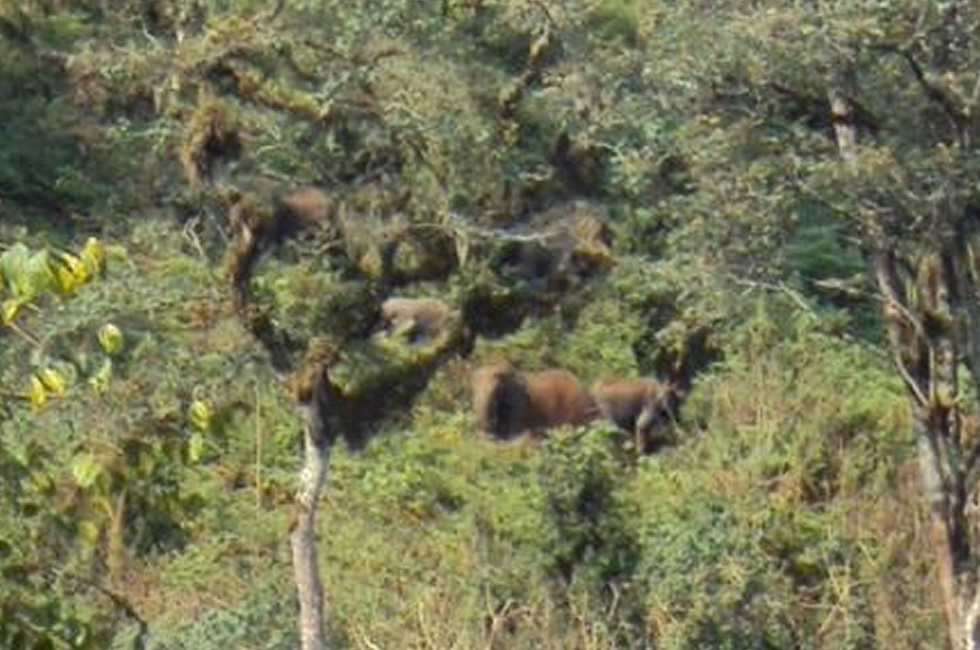The sudden crash hit the forest floor like thunder in the near distance. The ITFC tracker and field worker stopped, causing the team to fall short inches from him. His quivering lips, widened eyes, and stiff stance warned us all. Even the strong Uganda Wildlife Authority (UWA) guard with his long, threatening rifle and strict facial expressions, became uncharacteristically anxious. He grasped two of the researchers and held them back. Branches and bushes rumbled against the crashing sounds meters from us, on the thick forest floor. Our hearts pounded, some with excitement and others, apparent fear and caution. For most of us, we just stood in wonderment, waiting to hear the guide’s explanation. Could it be? Were we meters away from one of the most elusive, yet largest, creatures that inhabit the lush impenetrable forests that make up Bwindi’s National Park? That was the question going through our minds as we strained from the pushing, shoving and gentle grasp of our soldier and tracker. One thing was clear, they wanted to leave and fast!
Bwindi, as you can read from previous blogs, is home to many amazing, beautiful and mysterious creatures. From exotic butterflies to a variety of primate species, including the endangered mountain gorillas, the National Park is a treasure chest of information, exploration and wonder. That is why ITFC, in collaboration with the Max Planck Institute, hosted a small group of Rwandan mountain gorilla researchers and conservationists from the Karisoke Research Center, which is based in Rwanda as part of the Dian Fossey Gorilla Fund International. This exchange lasted for a weekend, where the group was split into two teams. One team would observe the Kyagurilo Gorilla Research Group while the other team went on a forest walk to Mbwindi Swamp. Teams would change the following day. And it was on this misty, Sunday morning that one of the teams would observe more than they thought on their forest walk.
We walked along the steep paths that are typical of Bwindi, meandering our way down towards the famous swamp. The team explored the forests, seeing some interesting birds. In the background, the “booms” and “pyows” of blue monkeys followed us, echoing across the forest. As we neared the swamp, there were elephant signs–tracks in the mud, dung on the ground. While the elephants are difficult to observe, such signs are everywhere. Never did we, or anyone else, think that we would actually see these giants.
The tracker and guide told us that we needed to move away and quickly. We would not be able to continue along the path towards Mbwindi. The crashing continued. But our curiosity won us over as we crunched, stretching on our toes, together on a fallen tree stump in order to see the mystery behind the dense vegetation. And there he was–a bull elephant! He was just meters away. We could see his thick, grey back as he slowly made his way through the bushes. As we crept away, we noticed more elephants, higher up on the sloping hillside. The team found a spot, on the opposite slope, where we could observe the herd without disturbing them. Once in awhile, one would make a loud trumpet vocalization. I am sure they could sense our presence but they continued to feed. We passed around binoculars, eager to get a better view of these giant, yet peaceful, and intelligent creatures. The team sat for over an hour observing the herd; 13 elephants were counted, including some infants. The infants suckled. One juvenile used her trunk to throw dirt over her back, to help cool herself from the heat. The large clouds of brown, gritty dust encircled her, adding to the misty day. The other infants nestled between the females.
There have been a few sightings of these elephants in Bwindi (several have been mentioned in past blogs). The population estimate was approximately 30 elephants through the National Park, however since they are so difficult to study this is just a rough number. Watching the 13 some elephants in front of us, we knew how lucky we were. We were also able to watch them for over an hour. It was more than we ever hoped to experience that day. The elephants are definitely one of the treasures that makes up Bwindi’s impenetrable realm.
Thanks to Joel Glick, one of the Karisoke visitors who was former assistant on the Max Planck Institute’s Mountain Gorilla research in Bwindi.


